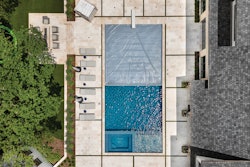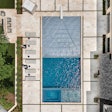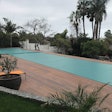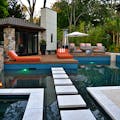
For some pool owners, an automatic pool cover represents enhanced safety, energy savings, reduced chemical consumption and protection against debris. That's all well and good, argue the contrarians, but covers just don't look cool.
That perception appears to be fading — especially if the winners in the pools-with-automatic-covers category of PHTA's 2024 Awards of Excellence, sponsored by AQUA, are any indication. They prove that, when given as much attention as other key elements, covers do not detract from a project's overall aesthetic.
"I've definitely done more covers in the past five years than I did in years prior," says Mike Farley, a renowned pool designer for Southlake, Texas-based Claffey Pools. "The design style in the last five years has been rectangular, so the design style is not limiting people wanting to put on a cover versus when the freeform was a big deal — back when I was doing pools in the late '90s and early 2000s. Back then, people were like, 'I want safety, but I'm not gonna do a stupid rectangle; I want a freeform pool.' So it was off the table. Right now, your design style and the cover are in step with each other."
The aesthetics of covers themselves are changing, too.
"We installed our first transparent but slightly opaque automatic cover [in 2024]," says Jerry Hammerschmidt, majority co-owner of High-Tech Pools in Cleveland, Ohio, which includes covers on about 80% of its projects. "The homeowner wanted to see the pool glowing even with the cover on. It's not gathering as much radiant heat, but it does create a cool-looking effect at night. It's like a spaceship. I think those types of covers may become a thing."

THREE BODIES OF WATER, THREE COVERS
The owners of the Gold-winning project in Moreland Hills, Ohio — designed by High-Tech Pools and completed in summer of 2023 — have six daughters from toddlers to teens. They opted for separate automatic pool covers on all three bodies of water, each of which feature glass tile: the diving-well pool, a kiddie pool and a raised spa. Lots of lights, colored bubblers, fire features, an in-water basketball hoop, and a water weir between the spa and the smaller pool serve as inviting accents.
The project's literal highlight is the sleek self-cooling, polished stainlesssteel slide imported from the British company Splinterworks at a cost of several hundred thousand dollars.
"When the sun hits it, you'd think it would get really hot," Hammerschmidt says. "But the water that sprays into the slide starts in the base and goes up the handrails and through each of the steps to get to the point where it sprays. So it keeps the unit cool to the touch, so you're not burning yourself. And it can be glary if you're in the wrong spot, but it is truly like a mirror. It's like a piece of art."
All told, the price tag for this project came to about $1 million, according to Hammerschmidt, and the cover plays a vital role in overall operations. "When you close the pool covers, the slide turns off. And if you close the slide pool or the kiddie pool, the weir turns off, so that you're not flooding the cover," he says.
Fun side note: In order to commence this project, crews ripped out the home's original pool, which High-Tech Pools had built on the same site two decades ago; that one was featured in Cleveland Magazine.
While some builders like Hammerschmidt include covers on most new projects, others might do so more sporadically. In those cases, it's critical for installers to understand that "certain bugs need to be worked out" when new covers begin operating, Hammerschmidt says. "That's something you have to explain to customers. Say, 'Listen, there are parts that wear on these covers before they operate perfectly smooth. Call us anytime something gets out of alignment, because we're basically dialing the cover in for it to work the way it's supposed to work.' We've learned that from over 30 years of installing these."
 Photo above and below courtesy Farley Pool Designs
Photo above and below courtesy Farley Pool Designs
 A 2024 Awards of Excellence winner in the Pools with Automatic Covers – Concrete category, this project designed by Mike Farley and built by Claffey Pools in Southlake, Texas, uses Platino limestone coping to neatly hide cover tracks and rails and provide a clean, majestic look.
A 2024 Awards of Excellence winner in the Pools with Automatic Covers – Concrete category, this project designed by Mike Farley and built by Claffey Pools in Southlake, Texas, uses Platino limestone coping to neatly hide cover tracks and rails and provide a clean, majestic look.
DESIGNING AROUND A VIEW
Farley has designed six pools for various members of the same family — and all of them have automatic pool covers that in no way diminish their beauty. In the case of the Bronze-winning project (pictured on page 36), located in Sunset Cove on Possum Kingdom Lake in north-central Texas, the cover adds safety for the homeowners and their guests, as well as protects against unwanted visitors and wildlife when the family is away. (While this is the homeowner's main residence, plans call for it to eventually become a second home.) Walk-on cover lids blend with the limestone deck, coping, steps and porch cap to seamlessly blend the home and pool area.
"It's called Sunset Cove because the sun sets perfectly over the cove, looking right into the house," Farley says. "So it's a really pretty setup that keeps the view open from the water out toward the lake."
Expanding on the picturesque setting is the pool's hillside location. The pool is located close to the main porch off the home's great room, with full-length steps descending 2 feet to the deck. The backside of the pool drops about 48 inches to the ground, so Farley added a built-in bench that spans the 43-foot length of the pool and provides an ideal spot to watch the sun go down.
Similarly, the flush spa at the deep end of the pool — where the cover resides — maximizes views, while the nearby fire pit is surrounded by additional seating and the cover box drop beam (which accommodates even more sunset viewers). An expansive tanning ledge and three bubblers accent the pool's shallow end.
"Typically, when you do auto covers, 90% of your spas end up [opposite the cover box]," Farley says. "People want to be able to just barely open the cover so they can access the spa, instead of rolling the whole thing off. For this scenario, the client has to open the cover up all the way, but that was what created a more functional design for them."
Unlike Hammerschmidt at High- Tech Pools, only about 10% of Farley's projects include covers. In some municipalities, door alarms that prevent people from entering swimming pool areas unattended provide a more costeffective and legal alternative to pool covers. But a cover accomplishes so much more.
"All covers do the same thing," Farley says. "They make it so the pool is cleaner when you use it, you can use the pool longer because it stays warmer in the spring and fall, and the pool's safer because it's covered. It gives you greater peace of mind, and you can't put a price tag on that. But some people don't even know a cover is an option. That's the fun of my job; I get to help people decide what's best for them."
 All told, the price tag for this project came to about $1 million, according to Jerry Hammerschmidt, co-owner of High-Tech Pools, and the cover plays a vital role in overall operations. "When you close the pool covers, the slide turns off. And if you close the slide pool or the kiddie pool, the weir turns off, so that you're not flooding the cover," he says.
All told, the price tag for this project came to about $1 million, according to Jerry Hammerschmidt, co-owner of High-Tech Pools, and the cover plays a vital role in overall operations. "When you close the pool covers, the slide turns off. And if you close the slide pool or the kiddie pool, the weir turns off, so that you're not flooding the cover," he says.
This article first appeared in the February 2025 issue of AQUA Magazine — the top resource for retailers, builders and service pros in the pool and spa industry. Subscriptions to the print magazine are free to all industry professionals. Click here to subscribe.



































